|
|
|
|
| 2 , 60 , |
| Gerhard Hecht |
| Franz Vohwinkel |
| Kosmos |
| 2017-02-05 |
| Adrian Kügel (ak15) |
| Boardgamegeek | 161530 |
| 2,71/5 |
|
|
|
|
|
|
If you are reading these rules for the first time, ignore the text along the right hand side. These rules serve as a summary to help you quickly familiarize yourself with the game.
Show
→ summary only
→ detailed version only
→ both summary and detailed version

Hunters and Scouts
Each player leads a tribe in the Stone Age. By playing Character
cards, the player sends his tribe members to various Locations
(Wilderness, Hunting Grounds and Sacred Places cards). On each
turn, he decides whether to play a Character card or recall some of his
tribe members back to the Tribal Village. In the Hunting Grounds,
tribe members collect meat and skins. In the Wilderness, they collect
resources in order to create useful items. Each player has only until
sunset to collect enough meat for the day for his hungry tribe in order to
earn Victory Points.
The winner is the first player who leads his
tribe successfully enough to earn 24 Victory Points.
Game Components
1 Game Board
24
31
18
18
6
2 Tribal Villages
2 Victory Point Markers


10 tribe members (5 black, 5 white)


30 Consumption Stones

16 Hunger Tiles

The rules for the easier “Introductory” game
are explained first. The additional rules for the “Normal” game
are here.
For those who would like a real challenge, there is the
“Fight for Survival” variant
.
Preparation
-
Create three columns each consisting of one Advanced Scout
covered by a Shaman.
- Place 2 Wilderness cards face-up below the Wilderness stack.
-
Each player starts with 2 tribe members; another one
is placed on the Game Board.
-
Each player receives the five cards Hunter, Scout, Chief, Collector,
and Offspring.
-
Each player receives 2 item cards.
-
Each player starts with 10 points and 2 Hunger Tiles.
-
Before your first game, carefully detach the Game Board and
the Hunger Tiles from their frame, and place the Game Board on
the table, between the 2 players.
-
The 6 Sacred Places cards are not used in the Introductory Game
and are placed back in the box.
-
Of the 12 Special Characters cards (those with an orange bar on
the left), only the 3 Advanced Scouts and 1 Shaman are needed
in the Introductory Game. The 8 remaining Special Characters
are placed back in the box.
-
The 3 Advanced Scouts are placed in 3 columns next to each other.
3 Shamans are placed on top of each Advanced Scout card, somewhat
offset, in order to keep the card names visible. These 6 cards
form the display.
-
Each player takes the 5 tribe members in 1 color, 1 of the
Tribal Village cards, and places the Tribal Village card with the
“Sunset / Introductory Game” side face up in front of him. He then places
2 of his tribe members on the card, and 1 other on the Game Board.
The last 2 tribe members
are placed next to the Game Board to create a supply area.
-
From the stack of “Normal” Character cards, each player takes
the following 5 cards: 1 Hunter, 1 Scout, 1 Chief, 1 Collector,
and 1 Offspring.
-
Place the 2 Victory Point Markers on the Victory Point track of the
Game Board, on the “10” space.
-
Shuffle the Item cards and deal 2 items to each player. Each
player looks at them and places them face down in front of him.
These are items he can create during the game. The rest
of the Item cards are placed as a draw stack next to the
Game Board.
-
Each player receives 2 Hunger Tiles, which are placed
next to his Tribal Village card. The rest of the Hunger
Tiles, as well as the Consumption Stones, are placed next
to the Game Board in the supply area.
-
The 2 sets of Location cards (Wilderness and Hunting Grounds)
are shuffled separately and placed face down as 2 draw stacks
near the Game Board. The top 2 Wilderness cards are drawn
and placed face up below the Wilderness stack.
-
The player with the most hair is the starting player. Each player
will then take turns back and forth.
At yucata the starting player is chosen randomly.
Game Turn
On a player’s turn he may take one of the 3 following actions:
Play one Character card: Follow the instructions on the card.
a) Play one Character card
-
At the start of the game, each player has 5 Character cards to
choose from. If a player wishes to play one of his Character cards,
he first follows all instructions on it from top to bottom. He then
places the card in the display, in the column containing the least
number of Character cards. If there is more than one such column, he
may choose which column to place it in.
-
Most of the Character cards allow a player to place his tribe
members on Location cards, in order to retrieve them on a later
turn to collect resources. Important: Each Location card may
hold a maximum of 3 tribe members (counting tribe members
of both players).
Clarification:
It is allowed to move a tribe member from one Location card to
a new Location card, but in that case no resources are collected.
Retrieve any number of his tribe members from Locations:
Collect resources, discard Hunger Tiles, create items.
b) Retrieve any number of his tribe members from Locations
-
At the start of the game, each player has 2 tribe members, which
can be placed (using Character cards) on face up “Wilderness”
and “Hunting Grounds” Location cards.
-
By retrieving his tribe members and placing them back in his
Tribal Village, with each retrieved tribe member the player
gains 1 of the resources shown on the Location card where the tribe
member was retrieved from. This is designated by covering the
icon of the chosen resource with a Consumption Stone.
Clarification:
It is allowed to cover no resource if no resource is needed. But
in that case, it would also be possible to just let the tribe member
stay there, because it is allowed to move tribe members from one
Location to another. Therefore at Yucata it is enforced that
if you retrieve a tribe member from a Location, you also have to
cover a resource.
-
Resources available on the Location cards may consist of any
of the following: Meat, Skin, Stone,
Wood, Clay and Fruit.
-
The resources gained are not represented by actual tokens taken
by the player. Instead, they are “used” immediately as follows:
 When a player gains meat, for every meat icon covered,
he may discard 1 Hunger Tile back to the supply.
When a player gains meat, for every meat icon covered,
he may discard 1 Hunger Tile back to the supply.
 When a player gains 2 skins (each tribe member collects 1 skin),
he may take 1 tribe member from the supply and
place it in the “cave camp” on the Game Board. Later, he
may add a new member into the tribe by playing the
Offspring Character card, and moving 1 tribe member from
the cave camp to the Tribal Village card, thus gaining an
additional tribe member available for use. Remember that
at the start of the game, each player already has 1 tribe
member in the cave camp, ready to be “born”.
Clarification:
When playing the Offspring Character card, a player only has to take a
Hunger Tile if he also receives a tribe member.
When a player gains 2 skins (each tribe member collects 1 skin),
he may take 1 tribe member from the supply and
place it in the “cave camp” on the Game Board. Later, he
may add a new member into the tribe by playing the
Offspring Character card, and moving 1 tribe member from
the cave camp to the Tribal Village card, thus gaining an
additional tribe member available for use. Remember that
at the start of the game, each player already has 1 tribe
member in the cave camp, ready to be “born”.
Clarification:
When playing the Offspring Character card, a player only has to take a
Hunger Tile if he also receives a tribe member.
When a player gains other resources, he can create items
by playing any of his face down Item cards. At the start of the
game, each player has 2 item cards. To create an item, the
player must have gained all resources needed for that item
at the same time (from the Location cards). The resources can
come from 1 or more Location cards. Most items will earn
Victory Points for the player who creates them.
Perform a “Sunset” scoring: Intermediate scoring.
c) Perform a “Sunset” scoring
If the player has no more Character cards in hand to play, and does
not wish to retrieve any of his tribe members, he may perform a
“Sunset” scoring for his tribe by following these 3 steps:
-
The player receives 1 Victory point for each of his tribe members
on his Tribal Village card and any Location card. Important: Any tribe
members in the cave camp or in the supply do not score Victory
Points.
For each Hunger Tile the player posseses, he must
deduct
1 Victory point.
After calculating the number of Victory Points earned, the player
moves his Victory Point Marker forward on the Victory Point track by
that amount.
Note:
If a player has many Hunger Tiles, it may happen that he will
not earn any Victory Points, and he may even lose Victory Points. In
this case, he will need to move his Victory Point marker backwards
the appropriate number of spaces on the Victory Point Track. A player,
however, cannot have less than 0 Victory Points at any time.
Timing of the “Sunset” scoring: Normally, a player will only perform
a “Sunset” scoring when he has no Character cards left in his
hand. However, it may be beneficial to choose to perform this action
at an earlier time. If he does this “early” scoring, he must deduct
1 Victory Point for each Character card in his hand as a penalty.
-
For each of his tribe members on his Tribal Village card and any
Location cards, the player must take 1 Hunger Tile. Important:
The player keeps all previously obtained Hunger Tiles in addition to
those he receives during the “Sunset” scoring.
If a player ever has 8 or more Hunger Tiles, he must return one
of his tribe members (from either a Location card or his Tribal
Village) back to the supply area as a penalty, but he may also
discard 3 of his Hunger Tiles.
-
At the end of the “Sunset” scoring, the player takes 6 Character
cards from the display into his hand. The player may choose cards
from one or more of the three display columns. However, he may only take the top
card from any column. Once a card is taken, he can take the next,
now exposed, Character card from the same column or the top card
from another column. The player may also take any Special Characters
if they are the top card of a column. In this way, the player
assembles his hand of cards for the next day of his tribe.
Note:
If the player still has 1 or more cards in his hand (due to an “early”
scoring), he still takes 6 cards from the display, and will therefore
play the next day with more than 6 cards total.
At Yucata there is an additional restriction when
an "early" scoring is allowed: It is only allowed
if the required number of Character cards can be taken
(6 cards in the Introductory Game). Also, the remaining
cards in the display plus the handcards of the other player
should be sufficient for another “Sunset” scoring. This
rule enforces that a player can always perform a “Sunset”
scoring in case he has no Character card left in his hand.
Example: There are 7 cards in the display. If the other player
has at least 5 cards in his hand, a “Sunset” scoring is
allowed. If the other player has less than 5 cards, a “Sunset”
scoring is not allowed, because after this “Sunset” scoring
there would be only 1 card left in the display, and even if the
other player discards all his cards, there would not be enough cards
for him available to perform a “Sunset” scoring.
The Item cards
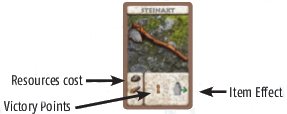
-
To create an item you have to collect all required resources
at once.
-
By retrieving his tribe members, a player can
create one or more items. To do this, he selects one of his Item cards and places it
face up in front of him. The bottom left corner of the Item card
shows the resources needed to create the item. For each resource
shown on the card, the player must retrieve one of his tribe
members from a Location card supplying the proper resource, and
then cover the icon of that resource with a Consumption Stone.
Important: It is not possible to create an item by collecting any
“missing” resources at a later time. If a player cannot collect all
of the necessary resources at the same time, he can not play that
Item card.
-
When creating an item, most of the Item cards will earn the
player 1, 2 or 3 Victory Points, and the player immediately
moves his Victory Point Marker forward on the Victory Point track by
the appropriate amount. Note: The Item cards “Hand Axe” and
“Vegetable Patch” do not earn the player any Victory Points.
-
Many items have 1 or 2 additional effects, shown as the
following icons in the bottom right corner of the Item card:

Place 1 of your tribe members
on any Location card
|

Draw 1 Item card from the stack
|

Take 1 Hunger Tile
|

Discard 1 Hunger Tile
to the supply
|
-
Clarification:
Effects of items are processed in the order from left to right.
The Victory Point Track
-
When reaching or passing bonus fields, the player can
get an additional Victory Point by discarding two of
his created items.
-
The final space on the Victory Point track can only be
reached with at most 3 Hunger Tiles.
-
The Victory Point track on the Game Board
keeps track of the progress of the two tribes.
The players can earn Victory Points during a
“Sunset” scoring, and through the creation
of items by playing Item cards.
-
Each player starts the game with 10 Victory Points.
-

The Victory Point track spaces containing cave paintings
(#9, 14 and 18) are bonus spaces. Whenever a player
reaches or passes one of these bonus spaces, he may choose to
discard 2 already built Item cards in order to
gain 1 bonus Victory Point. If the player does not have 2 built
Item cards at the time he reaches or passes one of the bonus
spaces, he cannot receive the bonus Victory Point.
-
In order to be able to reach the final space on the Victory Point
track (space #24, containing a hand icon), the player may hold
no more than 3 Hunger Tiles. If he has more than 3, he must
end his movement on space #23, and cannot advance further until
he holds 3 or less Hunger Tiles.
Game End
-
If a player reaches 24 or more victory points, the game ends after
both players have taken the same number of turns.
-
The player with more victory points wins, in case of a tie the
second player wins.
-
Once a player reaches the final space on the
Victory Point track (#24, with hand icon), the
game ends. If he earns more than 24 VP, he
continues movement to (or past) the #1 space.
-
If the starting player reaches the final space first, the second
player may take one last turn, so that both players get an equal
number of turns. If the second player cannot reach the final
space on his last turn, the starting player wins the game. If the
second player does reach (or surpass) the final space, then the
winner is the player who has progressed the furthest on the
Victory Point track. In case of a tie, the second player wins.
-
If the second player reaches the final space first, the game ends
immediately, and the second player wins the game.
At Yucata the additional rule holds, that in the (unlikely) case that
a player has all his tribe members in the supply (because he had to
return them because of too many hunger tiles), this player immediately loses
the game.
Additional Notes
-
Each player only places and retrieves his own tribe members,
never those of his opponent.
-
Whenever a player’s Character card instructs him to draw either
a Wilderness or a Hunting Ground, he draws the card from the
appropriate draw stack, and places it face up under the other
cards of that type, at the bottom of the row. This Location is now
available to use.
-
If, at the end of a turn, no Wilderness card is in the display,
a new Wilderness is revealed from the Wilderness stack and placed
below it.
-
Whenever a player discards an Item, Wilderness or Hunting
Ground card, he places it face up on the associated discard pile,
which is formed for each of these types of cards. If a draw stack
is ever exhausted, that discard pile is shuffled to create a new
draw stack.
-
Whenever a player’s Character card instructs him to cover a
resource on a Location card with a Consumption Stone, he may
select any empty space he likes.
-
Players are allowed to keep an unlimited number of Item cards
in their face down stack. There is no obligation to create items.
-
Whenever a player retrieves tribe members, he may decide the
order in which this happens.
-
A player must execute all actions from a newly-created item
before creating another item on the same turn.
-
If a player places a tribe member on a Location card due to an
item’s effect, he cannot retrieve that tribe member
on the same turn.
-
Whenever a player places a tribe member on a Location card, he
may place it on any Location card as long as there are
no more than 3 tribe members (of either player) on that
Location card afterwards.
-
When the last resources icon on a Location card is covered
(used), the card is placed on the appropriate discard pile, and
the Consumption Stones are placed back into the supply area.
If any tribe members remain on the card, they are returned to
their respective Tribal Village card.
-
Two of the Hunting Grounds cards (Sabertooth Tiger)
show a 1-Victory Point icon, in addition to icons for Meat and
Skins. If a player retrieves a tribe member from one of these Locations,
he may cover the Victory Point icon with a Consumption
Stone, instead of a resource, and immediately move forward by
1 Point on the Victory Point track.
-
If at any time there are insufficient Consumption Stones in the
supply area, players discard the Location card containing the
most Consumption Stones on which there are no tribe members.
The Stones are placed back into the supply area. If more than 1
Location card have an equal number of Stones on them, the player whose turn
it is may select any one of them. If there are no Location cards
containing no tribe members, the player may discard any card,
and any tribe members on it are returned to the proper player.
-
If a player plays the Offspring Character card and has no
Hunger Tiles, he does not take one despite instructed on the card.
-
In order to thwart his opponent, a player may retrive tribe
members from Location cards and cover resource icons with
Consumption Stones, even if he is not able to use the covered
resources at that time.
At Yucata the Consumption Stones are treated as an unlimited resource.
The rule for the case that 30 Consumption Stones are not sufficient
is not implemented.
Normal Game
Once you have played the Introductory Game at least once, you
may wish to try the Normal Game on your next play. All rules of
the Introductory Game also apply to the Normal Game, with the
following changes and additions:
Game Setup
-
Each player places his Tribal Village card with the
“Sunset / Normal Game” side face up in front of him.
-
Each player receives, in addition to the 5 “Normal” Character
cards as in the Introductory Game, 1 Shaman (also from the
“Normal” Character cards stack).
-
All 12 of the Special Characters are shuffled. 6 are drawn
randomly and placed in 3 columns of 2 (as in the Introductory Game)
to form the display. The 6 unused cards are returned to the box.
-
3 of the 6 Sacred Places cards are drawn randomly and placed
face up next to the Game Board. Each of the Sacred Places cards
has a different function on both sides. The 3 unused cards are
returned to the box. Note: When using the Sacred Places cards
for the first time, it is recommended to use these 3 cards:
Mammoth Graveyard, Ice Cavern and Mud Springs. In later
games, players can select the Sacred Places cards randomly,
or decide together which 3 cards to use.
-
Place the 2 Victory Point Markers on the Victory Point track of
the Game Board, on the “3” space.
-
The older of the 2 players plays first, and only receives 1 Item card.
His opponent receives 2 Item cards.
Performing a “Sunset” scoring
-
After receiving his victory points for a “Sunset” scoring, a player
must discard all but 1 of his face-down Item cards. This does
not apply to the already created items in the display.
-
At the end of his “Sunset” scoring, a player may take 5, 6, or 7
Character cards from the display into his hand.
Note: These additional rules are also listed on the “Sunset / Normal
Game” side of the Tribal Village card, for reference.
The Sacred Places
-
The Sacred Places cards are additional Location
cards, and just as the Wilderness and Hunting
Grounds players may place a tribe member
on them.
-
Any number of tribe members may stand on
a Sacred Place, but they must all be tribe
members of the same player.
-
In order for a player to place tribe members on a Sacred Place
containing tribe members of the other player, he must place a
greater number of them than the other player currently has
there. The other player then returns his tribe members to his
Tribal Village card.
Example: Player 1 (Black) has 1 tribe member on the
Mammoth Graveyard. Player 2 (White) plays a Collector, and thus may
place up to 4 tribe members at any Location. He decides to place
2 of them on the Mammoth Graveyard, which replace Player 1’s
tribe member there. Player 1 returns his tribe member to his
Tribal Village card. Player 2 could instead have chosen to place
3 or 4 tribe members there, making it more difficult for Player 1
to reclaim the Mammoth Graveyard later in the game.
-
Each Sacred Place has a different function, which is only in effect
if the “Trigger” condition is met.
-
In order for a player to use the function of a Sacred Place, a player
must have at least one of his tribe members there on his turn.
Clarification:
The function of a Sacred Place is handled in an extra phase at the end
of a turn. At the beginning of this extra phase, there must be a tribe
member at the Sacred Place in order to use its function.
“Fight for Survival” Variant
Once you have played the Normal Game a few times, you
may wish to try your hand with this variant, in which players
truly learn the struggles of Stone Age life. All rules of the
Normal Game apply here, with the following additions:
-
On most Hunting Ground
cards (except the Sabertooth Tiger), some of the
resource icons show a small
Skull in the corner. If such a
card is drawn, those resources
are immediately covered with
a Consumption Stone. This
means that there will be
less meat and skins available
for the players.
-
Whenever a player reaches or passes one
of the bonus cave painting spaces and
does not have 2 already built Item cards
to discard, in addition to not receiving the
1 bonus Victory Point he must now also
take 1 Hunger Tile.
Appendix
Character Cards
Hunter (2x)
Place 1 consumption stone on each hunting ground. Draw 1 hunting ground. Place up to 3 tribe members on it.
Scout (2x)
Place 1 consumption stone on every wilderness. Draw 1 wilderness. Place up to 1 tribe member on any location.
Collector (2x)
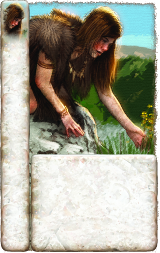
Collector
Place up to 4 tribe members on any locations.
Chief (2x)
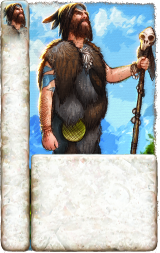
Chief
Draw 1 item. Place up to 2 tribe members on any locations.
Offspring (2x)
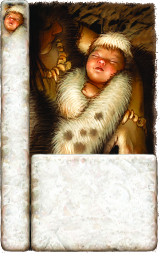
Offspring
Take 1 tribe member from the camp and place it on your tribal card. If you have hunger tiles, then take 1 more.
Shaman (3x)
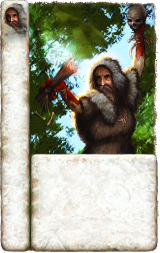
Shaman
Draw 2 items.
OR
Take 1 exposed character.
Advanced Scout (3x)
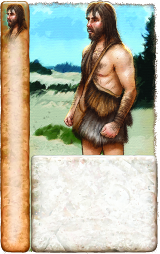
Advanced Scout
Place 3 consumption stones on 3 different locations. Draw 1 wilderness.
Place up to 2 tribe members on any locations.
Fisher (2x)
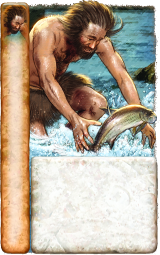
Fisher
Discard 2 hunger tiles. Draw 2 items and choose 1.
Basket Maker (2x)
Draw 1 item. Discard any number of items and draw as many new items. Receive 1 victory point.
Fireman (2x)
Place every tribe member on any locations
OR
Place 1 character in the display.
Tracker (2x)
Place 1 consumption stone on every wilderness and hunting ground.
Draw 1 wilderness or one hunting ground.
Place up to 2 tribe members on any location.
Items
Stone Axe
(2x)
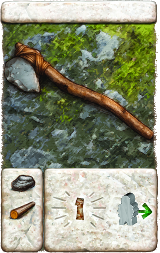
Stone Axe
Hand Axe
(2x)
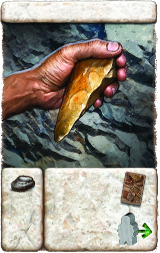
Hand Axe
Wooden Wheel
(2x)
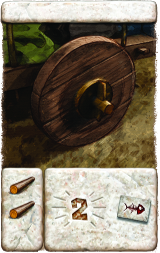
Wooden Wheel
Vegetable Patch
(4x)

Vegetable Patch
Clay Oven
(2x)
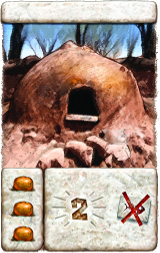
Clay Oven
Millstone
(4x)
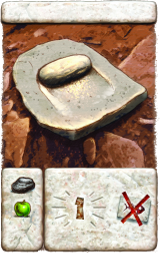
Millstone
Mortar
(2x)
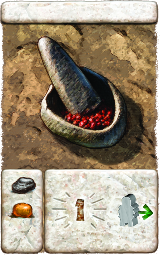
Mortar
Stone Hut
(1x)
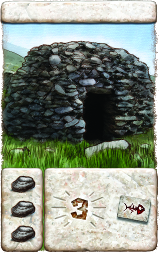
Stone Hut
Boots
(2x)
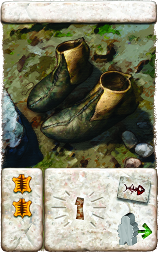
Boots
Drum
(3x)
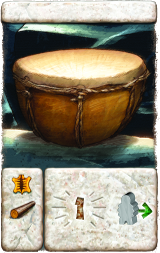
Drum
Weaving Frame
(2x)
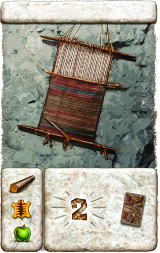
Weaving Frame
Shelter
(2x)
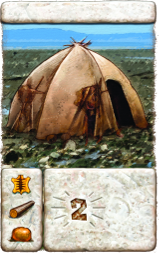
Shelter
Wilderness
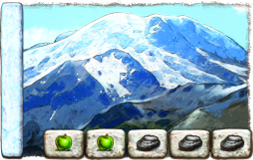
Mountains
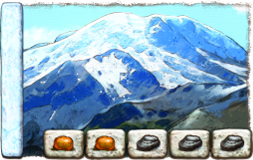
Mountains
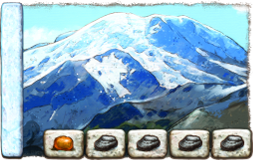
Mountains
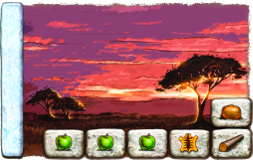
Savanna
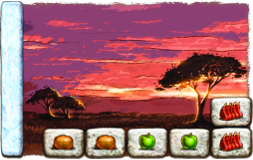
Savanna
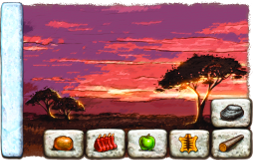
Savanna
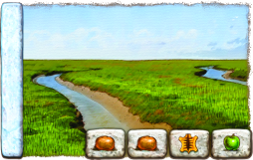
Marsh
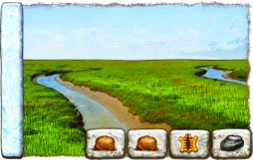
Marsh
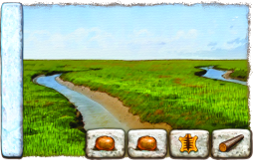
Marsh
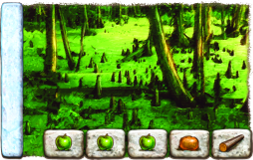
Swamp
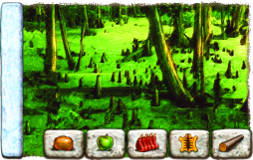
Swamp
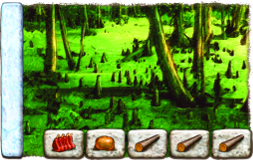
Swamp
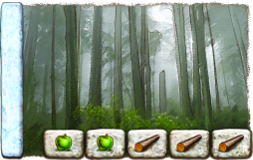
Forest
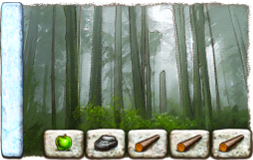
Forest
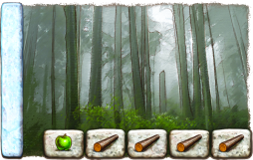
Forest
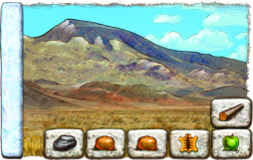
Desert
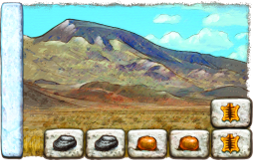
Desert
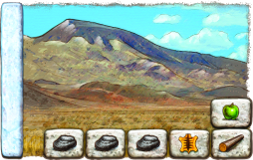
Desert
Hunting Grounds
Glyptodon
(3x)
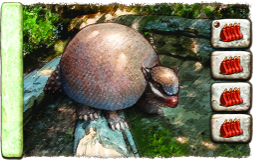
Glyptodon
Macrauchenia
(2x)
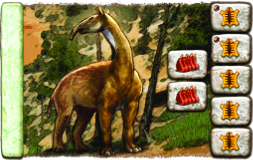
Macrauchenia
Megatherium
(2x)
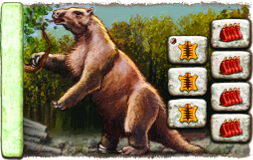
Megatherium
Toxodon
(3x)
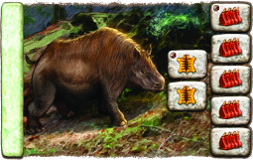
Toxodon
Cave Bear
(5x)
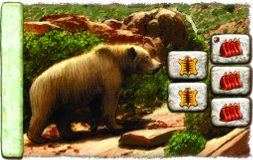
Cave Bear
Mammoth
(1x)

Mammoth
Sabertooth Tiger
(2x)
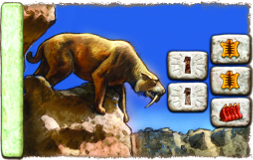
Sabertooth Tiger
Sacred Places
Mammoth Graveyard
(front)

Mammoth Graveyard
Hunter :

Trigger: You play a "Hunter".
You receive 1 victory point.
Waterfall
(back)
Trigger: You gather "meat".
Each of your tribe members can gather 2 meat.
Stone Arch
(front)
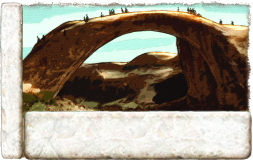
Stone Arch
Trigger: At your "Sunset".
Place up to 3 tribe members on any locations.
Ancient Oak
(back)
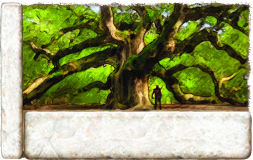
Ancient Oak
:

Trigger: You create an item.
Discard 1 hunger tile.
Mud springs
(front)
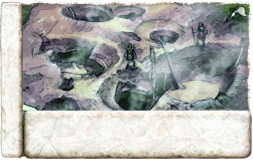
Mud springs
Trigger: You gather 2 "skins".
You gain 1 victory point instead of the skins. (The skins are consumed.)
Spirit Cave
(back)
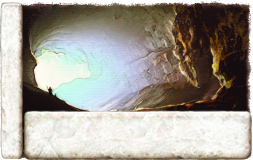
Spirit Cave
Offspring :

Trigger: You play an "Offspring".
You gain 1 victory point instead of 1 new tribe member.
Misty Glen
(front)
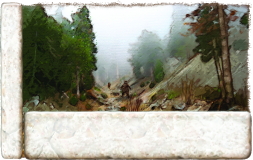
Misty Glen
Trigger: At your "Sunset".
You may keep 2 items. Place 1 tribe member on any location.
Ice Cavern
(back)
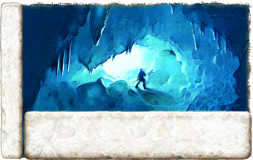
Ice Cavern
Trigger: At your "Sunset".
You may keep 3 items.
Geysers
(front)
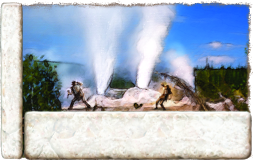
Geysers
Trigger: You skip your turn.
Draw 3 items.
Ancestry Hill
(back)

Ancestry Hill
:

Trigger: At your "Sunset".
Take 1 exposed character.
Herb Heath
(front)
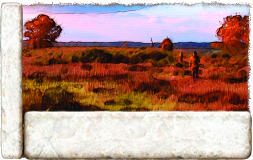
Herb Heath
Trigger: At your opponent's Sunset.
Discard 1 hunger tile. Draw 1 item. Place 1 tribe member on any location.
Sanctuary
(back)
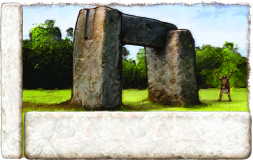
Sanctuary
:

Trigger: At your "Sunset".
You gain 1 victory point.
Hints for Handling
-
You can switch between the display of the character cards
and the item cards by clicking on the respective symbol.
For example if currently the character cards are displayed
and you want to look at the items instead, click on this symbol:

-
To discard a character card, click on one of the three columns
which are displayed above the draw stacks.
-
To perform a “Sunset” scoring, you can click on the
button "Sunset" in the bottom right corner.
-
For actions where the player has no choice, some of them are
executed automatically. For example if a player needs to
discard a character card, and there is only one column
which can be chosen, or all columns which could be chosen
have the same character cards in the same order, then the
discarding is done automatically.
-
The player info shows how many "born" tribe members the player has.
The number of "unborn" tribe members is displayed on the Game board.
The number of tribe members in the supply is not shown, but it
can be easily calculated (5 - "born" tribe members - "unborn" tribe members).
-
The Sacred Place "Geysers" (where you get three items if you pass) can
be used by clicking on the item stack at the beginning of your turn.
Of course this only works if you already have a tribe member at the
"Geysers" location.
-
The functions of Sacred Places will be used automatically
if there is still a tribe member on that location when the
function is evaluated. Since most of the functions are handled
at the end of a turn, the tribe member needs to remain there
if you want to benefit from the effect of the Sacred Place.
Example: if you want to use the functionality of the "Ancient Oak",
you will receive it if you have stopped taking tribe members back
and still there is one of your tribe members at the "Ancient Oak".
If you do not want to trigger the function of a Sacred Place, you
need to retrieve your tribe member in time (remember that you can
choose in which order you retrieve tribe members).
| |